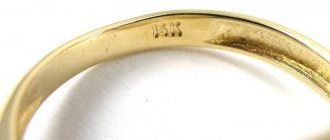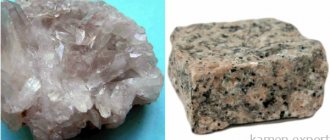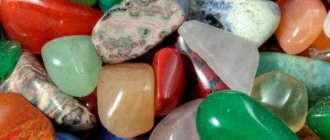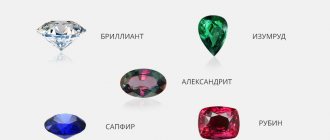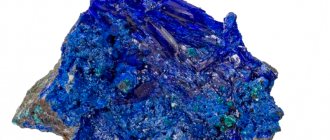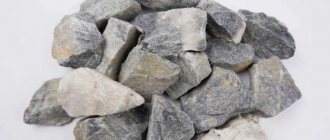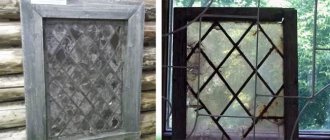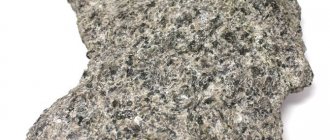The history of the Mohs scale
The creator of the system for determining the hardness of minerals is the German scientist Karl Friedrich Christian Moos. From a young age he studied physics, chemistry and mathematics, and after graduating from university he worked in a mine. In 1802, Moos moved to Austria and began work on systematizing the collection of minerals of one of the major businessmen. After 10 years, the scientist was invited to the city of Graz, where he participated in the creation of a scientific academy known as the University of Graz.
Among Mohs's many scientific achievements, the most famous is the creation in 1811 of a scale of mechanical hardness of stones. This was a remarkable solution at the time, since minerals were classified solely by their chemical composition. Mohs proposed a convenient scale of 10 positions, in which the highest score was assigned to the hardest mineral, diamond, and the lowest to soft talc.
Between them are located 8 more reference rocks in increasing mechanical hardness:
- talc;
- gypsum;
- lime spar (calcite);
- fluorspar (fluorite);
- apatite;
- orthoclase;
- silicon dioxide – quartz;
- topaz;
- corundum;
- diamond.
Currently, there are 2 modifications of diamond that are superior in hardness: fullerite and lonsdaleite. But the Mohs scale is still relevant. The hardness of granite is about 6.5 points - average between apatite and orthoclase. For comparison, the characteristic of marble is only 3.5 points, which is comparable to the hardness of a copper coin. Stones of different colors can have different characteristics. For example, granites with a pink tint, which you can read about here, are slightly softer than hard rocks, so they are often used for decorative purposes.
Chemical composition of granite stone:
Granite is an acidic igneous intrusive (frozen at depth) rock that has a crystalline-grained structure.
The rock is saturated with silicic acid and contains various alkalis; in smaller quantities it contains iron, calcium and magnesium. It consists of feldspars, silicate minerals (acidic plagioclase and potassium feldspar) of approximately 60%, quartz of approximately 35% and mafic minerals (melenocratic, such as biotite) of up to 10%. Thanks to spar, the color of granite is formed, and thanks to quartz, such a characteristic as hardness is formed. The most common color of granite is light gray, with rarer reddish-pink, yellow and even green shades of this natural stone. Quartz in granite is in the form of glassy and slightly fractured grain particles. They are most often colorless, but there are rare specimens with a bluish tint, which can affect the overall color of the breed. According to the types of crystal structure, granite stone is divided into fine-grained (no more than 2 mm), medium-grained (no more than 25 mm) and coarse-grained (more than 5 mm), with colors ranging from white to gray, pink and red, with characteristically shimmering inclusions of feldspar. The vast majority of samples are variegated. The shape of the pattern is influenced by both the natural structure of the stone and the direction that was chosen when sawing the monolith, as well as the tool used to cut the stone into granite slabs, paving stones or borders. Fine-grained granites are considered the most durable and durable. Granite (in Italian granito, from the Latin word granum - grain). Granite is the most common rock on the planet. The advantage of granite is its natural hardness and high wear resistance, high density and varied texture possibilities with various processing techniques. Granite stone is almost twice as durable as marble rock (although it is inferior to it in beauty), just like marble, it is easy to polish, has greater resistance to sudden temperature changes, unlike marble, and is more resistant to mechanical damage and exposure to various aggressive environments ( acid) substances. Since granite has a massive appearance and is associated with strength and durability, it is an excellent building material for exterior decoration, while the mirror surface obtained by polishing remains for a long time and can be renewed by repeated polishing. With its durability and wide range of colors, granite opens up wide possibilities for builders and architects. Many luxurious interiors, especially in old European cities, cannot be imagined without this natural material. Obtained during the production of granite or its processing, the relief texture of the surface perfectly emphasizes the monumentality of buildings or monuments while simultaneously achieving the effect of a play of light and shadow on the surface, which is often combined with shiny inclusions of mica plates. Its wide variety allows you to fill any space with a unique sense of history and significance, which can be cold and warm, modest and dazzlingly luxurious at the same time.
Physical properties:
Granite is highly resistant to environmental influences, including aggressive environments - precipitation and various acid-containing substances. Withstands long cycles of freezing and thawing at various temperature changes, the number of which can reach several hundred times.
The main characteristics of granite include:
Density – 3.17 g/cm3
Volumetric mass (specific gravity) – 2.7 g/cm3
Compressive strength (mechanical stress at which fracture occurs):
– wet – 550 kg/cm2
– dry – 604 kg/cm2
Abrasion (the ability of a material to change in volume and weight under the influence of abrasive forces) – 1.4 g/cm per m2
Water absorption (the ability of a material or product to absorb and retain water in pores and capillaries) – 0.2%;
Strength reduction factor – 0.9
Hardness on the Mohs scale (mineralogical hardness scale) – 6-7
Granite mining:
The main form of occurrence is batholiths (a large intrusive massif with predominantly cross-cutting contacts and an area of more than 100 km²), which represent a huge massif with an area of several hectares. Typically, the rock occurs in the form of dikes (a wall of stone), stocks (an intrusive body that has the shape of a column in a vertical section) and other intrusive bodies (a geological body composed of igneous rocks that have crystallized deep in the earth's crust). Sometimes it occurs that granite magma has formed layer-by-layer layers - injections. In this case, granite forms a series of sheet-like bodies that alternate with metamorphic and sedimentary rocks. Today there are three main methods - the rock chipping method, the explosion method and stone cutting. The last method is the most popular and expensive. It allows you to avoid microcracks and develop deposits more optimally, keeping granite stone intact during mining. In the stone cutting method, granite is cut into blocks, which are then sawn into slabs. The mining and geological conditions of the occurrence of granites make it possible to extract huge monolithic blocks - with volumes of up to several hundred m3 and weighing thousands of tons, which is impossible for any other types of natural stone. The resulting blocks are hewn and cut into piece stone or used whole in architecture. The stone is found everywhere in any region of the planet.
Features of education:
Natural stone granite is a crystalline, granular, massive volcanic rock formed by the slow cooling and further solidification of magmatic melt that occurs at great depths. Also, the origin of granite is possible during metamorphism (rocks formed in the thickness of the earth's crust as a result of metamorphism, that is, changes in sedimentary and igneous rocks due to changes in physicochemical conditions), that is, in the process of formation of granitization of different rocks. At the same time, very often granite massifs are attributed either metamorphic origin, sometimes igneous, and most often - mixed.
Scope of application of granite stone:
Granite is a material whose use dates back thousands of years. The most famous granite structures that have survived to this day are, of course,:
Trilithons of Stonehenge, weighing more than 50 tons (England, III-IV millennium BC)
Obelisk of Hatshepsut, weighing 343 tons and height 28.58 m (Egypt, 15th century BC)
Baalbek trilithon, weighing more than 1000 tons (Syria, 1st – 3rd centuries AD)
Granite products can retain their original shape for many centuries.
Since the main properties of stone are strength and durability, that is, the ability to maintain its processing texture and mirror surface for a long time, and also because the surface is difficult to dirty, granite is widely used for external cladding and finishing of buildings and structures (base slabs, parapets, etc.) and products for road and street construction (curb stones, paving stones, and also used in places that have high traffic (offices, banks, various public buildings, restaurants, bars, pedestrian crossings and much more). Granite is a stone with low water absorption - it practically does not absorb water. Because of this, it has high frost resistance. Also, due to the fact that these properties of granite have such better quality indicators, it is also perfectly used during the construction of ports and embankments, fountains, columns, ceilings. In the interior of premises granite is often used for wall decoration; staircase window sills, balusters, urns, vases, cornices and other complex-profile products are made from it. It is also resistant to sudden temperature changes, which allows it to be used for kitchen countertops and bar counters. Recent advances in the processing of granite stone make it possible to make products such as sinks from it. Their service life and sound absorption are unmatched.
Granite is also used to make objects of monumental art - pedestals, columns, pedestals, stylobates (the upper surface of a stepped plinth) and many others.
Strength
Marble is mainly composed of calcite, which has a category three on the hardness scale, so it can be easily scratched with a sharp knife. Fine-grained varieties of marble are the most durable, which is why they are assigned the second category on the strength scale.
Artificial marble is easily restored in case of mechanical damage and is designed to withstand heavy loads.
Comparison of impact resistance of natural and artificial marble
| Impact height (cm) | Artificial marble | Natural marble |
| 2,54 | Very weak mark | 0.16cm dia. notch |
| 5,08 | Weak mark | 0.48cm dia. notch |
| 10,16 | White mark | 0.48cm dia. notch |
| 20,32 | Weak notch | Fault |
| 30,48 | Weak notch | Fault |
| 91,44 | No rift | Fault |
Where are the most famous deposits?
Due to the prevalence of granite in the environment, there are many deposits of it throughout the globe. Some of them are famous for containing unusual varieties, such as Krivorozhskoye on the Ukrainian crystalline shield, which produces a rare black rock, or Chalotuiskoye and Etykinskoye in the Chita region with an amazonite bluish-green appearance.
More than 50 fields are being developed in Russia. The largest among them are: Kupetskoye and Dugoretskoye in Karelia, Shkurlatskoye in the Voronezh region, Mansurovskoye, Yuzhno-Sultaevskoye and Golovyrinskoye in the Urals.
A rare species, rapakivi, is being developed in the Leningrad region. Unusual gray and pink granites are mined in Kabardino-Balkaria and Yakutia. Other rare varieties of stone have been found in the following places:
- brick-red - Verkhne-Chebulinskoye deposit in the Kemerovo region;
- beige - Udalovskaya development in Altai;
- coarse-grained orange-red - Ushkanskoye deposit in the Krasnoyarsk Territory.
Europe is rich in deposits of this rock. It is mined in Portugal, Spain, Italy, Germany, and Great Britain. Development is also underway in North America, Japan, and the Scandinavian Peninsula. The leaders in production are Somalia, Ethiopia and Namibia.
Medicinal properties
Marble is also used in lithotherapy. Using marble balls, massage is performed to relieve pain from radiculitis, joint diseases, to get rid of nervousness and insomnia.
The stone helps to improve the health of the stomach, cardiovascular and respiratory systems. For this, lithotherapists recommend wearing a pendant, necklace or beads made of marble.
Wearing a ring or bracelet will help reduce the increased excitability of the nervous system and strengthen the nerves. You can wear these products at the same time.
In general, massage with balls and jewelry have a restorative effect and help lift your mood.
How marble is formed in nature and its history
The age of many deposits is attributed to the Archean, Proterozoic, and Mesozoic eras. Marble was formed due to the recrystallization of dolomite or limestone sedimentary rock. They became compacted and dehydrated under the soil when exposed to climate. The composition contains impurities characteristic of deposits of certain territories and countries.
Marble rock was used in all ancient civilizations. Archaeologists often find items from antiquity. Most often these are sculptures of gods, jewelry, and dishes.
Many marble buildings, including the Taj Mahal and St. Petersburg palaces, survived into the 21st century. The Roman municipality is decorated with sculptures symbolizing the Nile and Tiber rivers. Their durability is unlimited.
Nature of education
The formation of marble is the result of the so-called process of metamorphism: under the influence of certain physicochemical conditions, the structure of limestone changes and, as a result, marble is born.
Definition and formula of marble
Under normal conditions, it is a white powder (Fig. 1) that decomposes when heated and melts without decomposition under excess pressure of carbon dioxide. Practically insoluble in water, does not react with alkalis. Decomposes with acids and ammonium chloride in solution. It is transferred into solution by excess carbon dioxide, forming calcium bicarbonate.
Fig.1. Calcium carbonate (marble base). Appearance.
What is marble
Natural marble is formed from limestone or dolomite sedimentary rocks. The massif is granular, the color of the mineral is varied. The color of the base and veins depends on the type of secondary impurities. The pattern is heterogeneous, with curls. When heated, it does not emit harmful substances.
From Latin the word marble is translated as “shining stone”. This mineral really absorbs the sun's rays and seems to glow from within. The product begins to shine after polishing.
Varieties and colors
Marble is formed by the recrystallization of carbonate compounds in sedimentary rocks. Therefore, it can be calcite, dolomite, shell (with shell inclusions) and breccia (mineral fragments in calcite/dolomite).
Composite (artificial) stone is distinguished separately. It is made on a mineral basis. There is also marble onyx. This is a type of sintered banded marble, similar in appearance to onyx.
Types of patterns on marble:
- wavy;
- spotted;
- veined or veined;
- breccias (pieces of multi-colored minerals held together by a base substance).
The color depends on secondary impurities. The stone is single-colored, two-colored and polychrome. Most often, a rock with a small part of inclusions of a contrasting color is found.
Classification of marbles by color:
- single-color (a light or dark pattern is created by changing the concentration of the coloring impurity);
- breccia (colored, monochromatic base, color of fragments in any palette);
- plain white (pure, without impurities);
- white with yellowness, cream;
- black and white (example: Nero Markina - black background, white veins);
- white with streaks of gray, blue, gold or other colors;
- red (with an admixture of hematite and other iron-containing substances);
- shades of red with inclusions of impurities - pink, burgundy, purple;
- black marble with gold (graphite/bitumen with an admixture of pyrite or other mineral);
- gray or black monochrome (with an admixture of bitumen, graphite);
- gray with inclusions of a different color;
- beige with a coffee, dark or cream tint (with limonite and/or manganese);
- yellow or gold, with an amber tint (with limonite);
- yellow with a pattern of golden, beige, green, orange or other color;
- green with light inclusions of the same range (with an admixture of serpentine and other iron-containing silicates);
- green with streaks of contrasting color;
- blue (with a high concentration of diopside);
- blue (with low concentration diopside);
- brown of different shades (includes compounds of manganese, iron, limonite), example: Bidasar Brown or Gold;
- red or red-orange;
- purple with inclusions of a different shade - belongs to breccia, rare, known as violetto antico or la breche violette.
There are similar minerals. During gemological examination, serpentine stone is most often found instead of green marble. It is cheaper, which is often used by scammers. They also make imitation porcelain stoneware to look like black marble. It costs less, does not emit radiation, and is resistant to atmospheric phenomena.
White
White color is truly unique. It is this variety that is the main material for creating majestic sculptures and fancy figurines. Among the white stones you can find specimens with thin multi-colored veins, which give it a special charm and uniqueness.
Black
Black marble is an extremely rare variety that was formed as a result of volcanic activity. It often contains an admixture of graphite or bitumen. This colored type of stone is found with golden flecks or veins, making it especially valuable.
Green
The green color of marble occurs when it contains iron silicates. It is they who give it a rich dark color, and inclusions and veins are found in both brown and white. The design itself can be in the form of branches or waves.
Red
Red stone is very expensive and very unusual, and its color is due to the presence of iron oxide in its composition. The use of red marble in construction is closely related to the construction of ancient temples and palace buildings. At the present stage, it has long been in the status of a very expensive finishing material and is used to cladding rooms intended for large public celebrations.
Grey
Gray marble can have a coarse-grained structure, or, conversely, a fine-grained structure. The shades of its flowers are very diverse, with sparse or frequent veins: dark yellow, pinkish and white. There is also dark gray marble, which is especially resistant to harmful substances. All gray types of this stone are very easy to handle at any stage of processing.
Beige
“Warm” beige types of marble can be cream, coffee and deep dark in color. The patterns or inclusions on their surface have a particularly bizarre shape, which arises due to the appearance of limonite and manganese impurities. The strength of this material is very high, and therefore beige stone is often used for flooring. Tiles made from it are unpretentious in mechanical stress and can last for decades.
Pink
If you come across a pink stone, know that marble of this type, like its red varieties, has iron-containing impurities. They give it a soft pinkish tint, interspersed with dark green veins, giving it a special beauty.
Blue
Blue varieties of marble are presented mixed with gray and white colors. The blue color itself arises from diopside, and what color this type of marble will be depends on the amount of diopside in the composition. If there is a lot of it, the shade will be thick and even dark blue.
Yellow
Sun-colored marble is, of course, all shades of yellow, which are also present in the natural palette of stone. Shades of golden and beige, in addition to the main color, create amazing stains. Window sills, tables and countertops, as well as decorative elements are made from yellow stone.
Composition of granite
Natural granite, due to the fairly large amount of silicon oxide (SiO2), is considered an acidic rock. The stone also contains alkali, magnesium, iron and calcium.
However, feldspar and quartz are considered to be one of the main structural components of granite. It is the presence of quartz in the stone that determines its granular structure, due to which granite got its name (translated from the Latin granum - “grain”). Depending on the size of the grains, granites in the world are divided into:
- fine-grained, having a maximum grain size of 2 mm. This type of stone is recognized as the highest quality due to its certain characteristics.
- medium-grained, the grain size of which ranges from 2 mm to 10 mm;
- coarse-grained, having grains larger than 10 mm. Large grains negatively affect the quality of granite, since due to this it does not tolerate high temperatures, as a result of which it is able to increase in volume and crack.
As a rule, the amount of quartz in the rock reaches 30% of its total volume. It is worth saying that quartz is a highly hard mineral that participates in the formation of a fairly large number of igneous rocks. Quartz is a colorless element, but as a rock that is part of granite, it can be of different colors - yellow, pink, red, purple, etc.
Spar, present along with quartz in granite, is a mineral of the silicate group. Its percentage in the stone is 50% and above. In the rock, this element is represented by potassium feldspar (orthoclase, adularia) and acid plagioclase (oligoclase, bytownite, labradorite, etc.).
With the exception of quartz and feldspar, about 10% of granite is occupied by other inclusions, which include biotite, lithium micas, muscovite, and hornblende. Also in small quantities in the stone you can find accessory and alkaline minerals, which are apatite, zircon, as well as tourmaline, garnet and topaz.
Thus, scientists have come to the conclusion that the composition of granite is directly related to the process of its formation. In this regard, there are two main theories of granite formation. According to the first, it is believed that the formation of stone occurs during the crystallization of a magmatic melt. And the second theory states that the formation of granite was influenced by ultrametamorphism. Those. pressure, high temperatures and fluids that rose from the deep layers of the earth influenced the process of granitization.
How is marble stone mined and processed?
More often, marble rock is mined using open-pit mining. They are less often mined using the mine method, which increases the costs and labor intensity of the work.
The monolith is broken using drilling and cutting units. The mineral mass is cut into large blocks by a rope stone-cutting machine. Small deposits are separated with circular saws. Layered varieties are developed by hand.
Mineral raw materials are processed in factories. The blocks are cut into slabs using sawing machines with diamond attachments. They are made at least 15 mm wide. Afterwards, the surface is ground, polished, and sent to another workshop for sorting. Then they put it up for sale.
To watch a video of the processing of Italian mineral:
Place of Birth
There are deposits on all continents, often accompanying travertine (calcareous tuff). The Berezovsky stone hasgaspeite and aikinite are similar in appearance to marble rock. But they have a different texture.
Russian marble is popular according to the deposit:
- Koelga - white or grayish with yellow or brownish spots;
- Pershinsky - black;
- Belogorsk (Karelian) - white with pink or red;
- Ruskeala - mountain park of the Ruskeala deposit, where the film “The Dark World” was filmed and the Ruskeala Symphony festivals are held;
- Garmatushinsky - lilac;
- Ufaleysky - white;
- Kibik-Kordonskoye deposit - more than 20 varieties;
- Sayan - cream and pink with gray or brown inclusions;
- Ural - Shishimsky white, large-monolithic marble, Shabrovsky blue and blue.
Among the foreign types, Italian marble varieties include Bianco Carrara, Arabescato, Statuario, Calacatta and Calacatta Gold. It is a white rock with linear grey, silver or golden beige veining. Also popular is the Grigio Carnico look: an ash-black base with silver lines.
Italians sell Palisandro Classico marble. There are pastel and brown-purple colors. The pattern resembles the texture of wood. The country is also famous for the sculpted stone of Michelangelo's dreams. The deposit is located on the Monti Altissimo mountain. Sardinia is famous for its brown Daino Reale marble.
Spanish stone is known for the following varieties:
- Nero Marquina (Nero Marquina black);
- Crema Marfil (ivory);
- Rosa Valencia (pink to purple velvet or cream).
Indian Bidasar is famous: Green (green), Gold (golden), Brown (brown). Bidasar Green Marble is also known as Forest Green.
Greek white or semi-white Volakas marble and snow-white Sivec marble are in demand. There are 400 types of Turkish due to the variety of shades and patterns. Most often they buy Milas Lilac or Leylak for countertops, bath chairs, hammam, saunas, baths.
Stone from different countries of origin is supplied from Asia via China, since the rock is processed in their factories. There are significant savings in delivery. The Skif factory offers furniture, countertops, vases and other items made from artificial and natural Italian minerals.
All types of natural rock can be restored by professional repolishing after long-term use. Examples can be viewed on Dmitry Kashirin’s page.
You can see how the mineral is mined in Spain:
Interesting facts about granite
What basic information about the mineral granite is available today?
Speaking about this stone, one cannot help but note what interesting facts have been revealed throughout the history of this rock:
- The first thing worth noting is that granite contains a large amount of oxygen.
- As mentioned earlier, granite is a very hard material and it retains its properties for several centuries.
- This stone is not afraid of any weather conditions.
- Granite naturally has very beautiful colors and does not always come in gray. Stone can also make me happy with ordinary colors.
- The hardest granite is considered to be a fine-grained rock. Export of granite will primarily be carried out by such countries as India, China and Italy.
Recommendations for stone care
Keeping marble products clean and tidy is quite simple. To do this, you need to have a soft cloth and a piece of suede on hand. The cloth should be moistened in warm water, wrung out a little and wiped over the stone surface. A small piece of suede will be needed for polishing.
It is recommended to clean natural stone once every six months using special detergents. You can use dishwashing detergent after diluting it slightly with water. After cleaning, it is advisable to periodically apply polish to the surface of the product. This protective coating, which has dust-repellent properties, will help maintain the attractive appearance of the stone.
If greasy stains appear on it, you should deal with them carefully. Sometimes traces of mold form on products. We are talking about those stones that are exposed to the open air for a long time. Fungal microorganisms are eliminated using a non-concentrated chlorine solution. The composition of marble does not allow the use of substances containing abrasive components and various acids when caring for it. It is not allowed to clean marble stone with metal or plastic brushes or a vacuum cleaner.
Regular adherence to these simple rules will ensure that products made from excellent natural materials will retain their properties and will please the eye for a long time.

